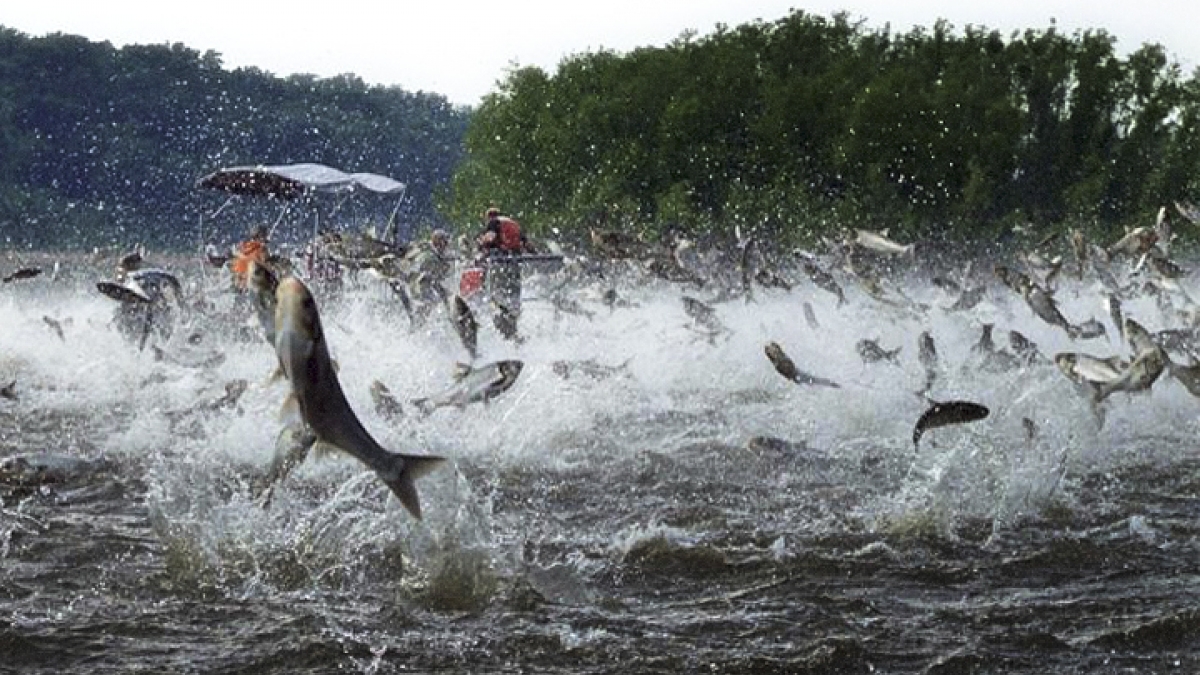
Asian carp swarm waterways near the Great Lakes. (Source: U.S. Congresswoman Mary Kaptur)

Asian carp swarm waterways near the Great Lakes. (Source: U.S. Congresswoman Mary Kaptur)
Fishermen caught more than 50 Asian carp in the upper Mississippi river basin in mid-March – the largest catch in previously non-infected waters. Now, state governments decided officials usually on the frontline of carp containment are “nonessential workers”, meaning they’re under a shelter in place order in the midst of the coronavirus pandemic, creating uncertain danger for carp-free waters.
“This latest capture is disturbing,” said Mark Fritts, a U.S. Fish and Wildlife Services ecologist based in Lacrosse, Wisconsin. “We’ve never seen that many fish caught at the same time in this region.”
In the upper Mississippi and Illinois rivers, Asian carp reproduce rapidly, have no natural competitors and out-compete native fish for food supply and space, which devastates native fish populations – in some streams, they make up 75% of fish biomass. Asian carp, which can weigh between 60 and 110 pounds, are also notorious for jumping up to three meters out of the water when spooked by boat motors or loud sounds – creating a public safety risk and threatening a $7-billion sport-fishing market.
Despite prevention measures, like government-contracted Asian carp fisherman and dam barriers, Asian carp have been slowly spreading upstream to the upper Mississippi river and the Great Lakes. Prior to this, Fritts believed that most of the population in the upper Mississippi river was confined below the Quad-City region in Illinois and Iowa. Now, he’s not so sure.
James Lamer, a large river ecologist with the Illinois Natural History Survey, said heavy flooding in the Mississippi river basin last spring may have caused the fish to spawn upstream.
Or, it could’ve been sheer luck.
According to Lamer’s research, Asian carp play favorites. From 2013 to 2016, Lamer and his team in Illinois tagged and tracked Asian carp migration through the Illinois and Mississippi rivers’ channels in search for some sort of pattern. They found that carp species and hybrids are more or less mobile based on different water temperatures, flow and volume, which makes their spread a little bit more predictable.
“The water temperatures are still really low, and that’s when they can aggregate,” Lamer said. “Lacrosse might have got lucky and just got a lot of fish in that one haul just because the carp tend to congregate during those cold-water temperatures in certain areas.”
From his research, Lamer knows that April weather brings favorable conditions to Asian carp in Illinois’ contained backchannels, which is a crucial time for government-contracted fishermen and researchers to extract invasive carp from the streams.
But due to the spread of coronavirus throughout the United States, Lamer said they might not be able to get out on the water and curb their spread.
“The only thing that we can do in the meantime is analyze data and try to figure out what we have going on with the data we have,” he said.
But Lamer isn’t too concerned – his research gives some hope to Midwestern waterways. Asian carp are finicky about their environment. Their preference for deep waters could keep them out of uninfected areas if the water levels continue at their current low levels, like they have been for the last couple of weeks.
“Long story short, I think any damage of not fishing for the one to two months off the water due to coronavirus can be mitigated when fishermen return to the water,” he said.
Even if water conditions are perfect, history shows the Mississippi’s unpredictable environment can be a natural barrier to carp mobility. For example, Lamer’s tagged carp had an abundant year in 2016, but had barely any sign of reproduction the next two years. Lamer and his team think it’s because changing water flow pushed unhatched carp eggs out of the upper Mississippi’s uninfected waters.
Lamer is keeping a positive attitude, but the “ifs” are adding up. In the worst-case scenario, Asian carp spread to uninfected waters and decimate native fish populations and the fishing economy.
The Midwestern waterways’ fate is up to Mother Nature.
“Asian carp have very variable recruitment and reproduction, and so if we had the water conditions are stable for them like they were in 2016, then it could be problematic if we’re not out there removing fish,” Lamer said. “If conditions aren’t conducive to spawning or movement and all of the gates stay in the water because we don’t get major flooding, it may not be as problematic.”
“It’s kind of a gamble – we’re hoping for the latter,” he added.
Fritts is less concerned, too. Last year Mississippi’s flooding set back his team’s research, and he said every year has its own challenges.
“My rocket is set on launch as soon as they give me permission to get back out there. But we’ll just do what we can. These forces are bigger than us and we’ll just do our best,” he said.